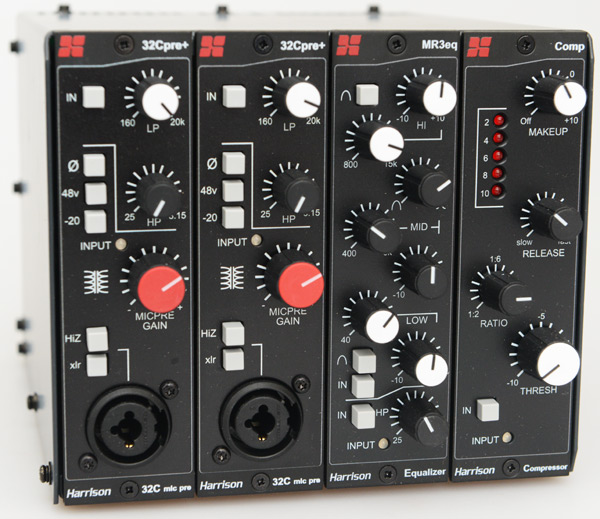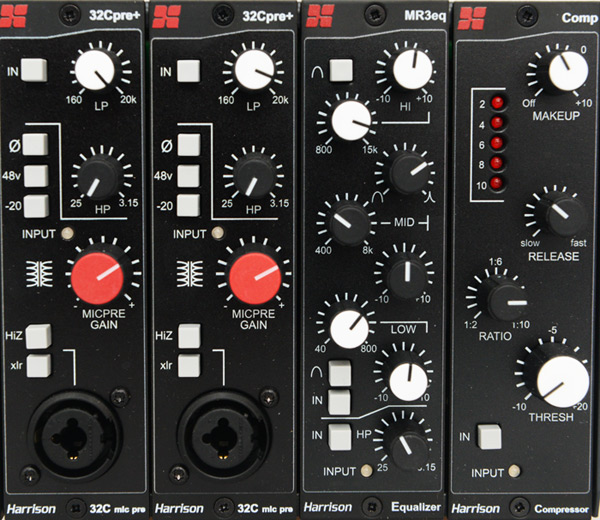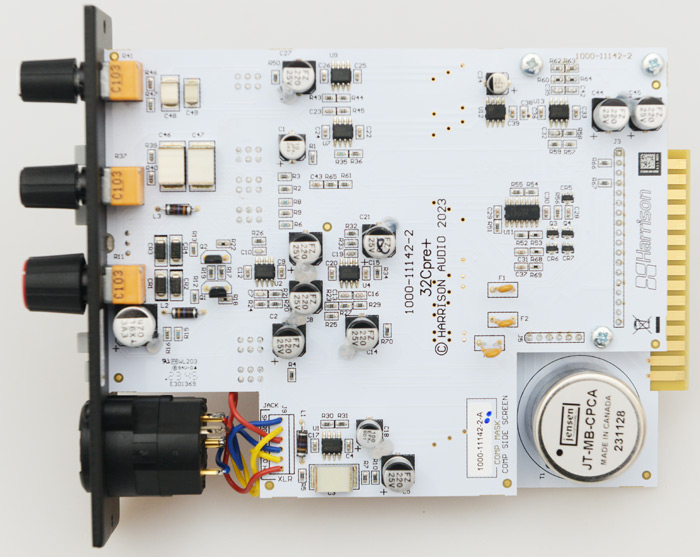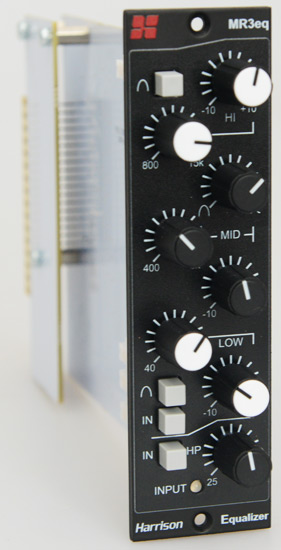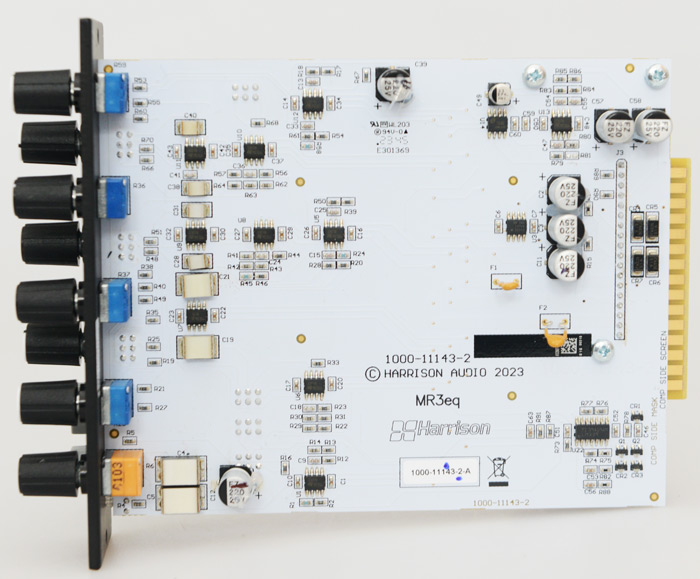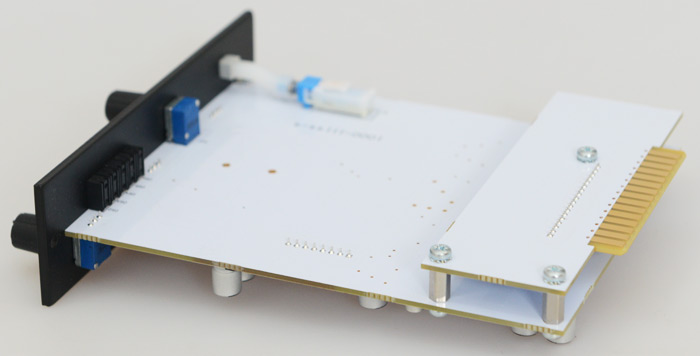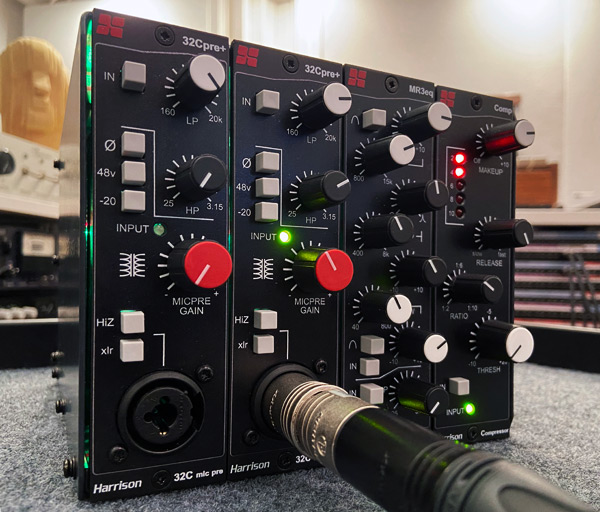Harrison 500 modules
32C-Pre+ preamp, MR3eq equalizer, Comp compressor
Author: Matthias Fuchs, Photos: Peter Kaminski, Matthias Fuchs (1)
Harrison Audio is one of the great classics among US mixing console manufacturers - and alongside API, it is one of those that have managed to successfully survive into the digital age. Founded in the early 1970s, the company, based in the music metropolis of Nashville, can look back at numerous innovations. For example, company founder Dave Harrison is considered the inventor of the inline console - although this was first implemented for his former employer, MCI, in their JH-400 console. However, Harrison’s first product with the simple name "32C" was also based on inline technology in 1975 and also offered innovative details such as routing with limited memory.
The 32C series was a huge success for Harrison and left its sonic mark on many top productions. These include recordings by Paul Simon, AC/DC, Led Zeppelin, Abba, Supertramp, and, above all, Michael Jackson’s legendary albums Thriller and Bad. But later Harrison products, including the large-format consoles of the MR series, also set new standards on several occasions. For a long time mainly dedicated to the film industry, Harrison has been a part of Audiotonix since 2023 and is now under the same roof as illustrious names such as SSL, Calrec, and Slate.
Recently, Harrison revived some of its analog recording classics - both in console and plug-in form, as well as under the guise of 500 series modules. The latter were available to us for this test. The modules were presented for the first time at the NAMM Show in January of this year and have been available ever since.
In a compact and high-quality OST-4 V2.0 lunchbox from Heritage Audio, we received a double pack of "32C-Pre+" microphone preamps as well as an "MR3eq" equalizer and a "Comp" compressor.
Similarities
Let’s first consider the obvious similarities between the modules. The three Harrisons are presented in plain black with unobtrusive but clean labeling. All of the knobs don’t have a grid and feel absolutely excellent. The switches have a slight lateral play but still work very precisely. Apart from a few multi-colored level LEDs, the very uncluttered front panels have little to offer - pure understatement, as we will see in a moment.
The front panels themselves have a material thickness of a generous two millimeters. The PCBs, which are largely assembled using SMD technology, have a comparatively simple but high-quality design and are manufactured in China. All three modules create a tidy and solid impression. The preamp uses a partially-discrete design consisting of high-quality op-amps and transistors. There is no housing to protect against electromagnetic interference. Our test specimens were mounted in a module rack without any problems whatsoever.
32C-Pre+ microphone amplifier
The 32C-Pre+ corresponds to the preamplifier of the current Harrison 32 Console, which in turn is based on the great classic vintage32C. In addition to the obligatory microphone input on the rear panel, the 32C-Pre+ also has a front panel input designed as a combo socket. It can be used either as an additional, alternative mic input (xlr setting) or as an instrument input (HiZ). This is very practical for experimenting with an alternative setup without having to change the cabling at the rear. Other features of the mic-in include phase inversion, 20dB attenuation, and phantom power, the switch for which is unfortunately inconveniently positioned and cannot be operated incorrectly.
In line with the Harrison classic, a Jensen transformer is located in the signal path; in this case, a JT-MB-CPCA with first-class performance data. According to the manufacturer, the input gain of the module is between +20 and +70dB. This means that there is also enough power to operate vintage ribbon mics. A multi-coloured LED visualizes the input level very reliably.
The two filters located behind the amplifier stage are extremely interesting - and another reminiscence of the vintage model. Each is a high-pass and low-pass filter with a slope of 12dB/octave and a frequency range of 25Hz to 3.1kHz and 160Hz to 20kHz, respectively. This means that the frequencies overlap in such a way that the signal can be shaped over a wide range and even faded out completely.
The sound of the Harrison 32C-Pre+ is convincing across the board. It treats the input signal in a very civilized manner and convinces with a neutral but certainly not lifeless sound. Even at low gain settings, there is a tendency towards subtle and appealing coloration. The transformer provides an inconspicuous but noticeable rounding-off of the signal. The high-level output signal always remains very clean. Vocals and guitars sound open and brilliant, basses growl beautifully round and powerful - you recognize and appreciate the pleasant touch of American rock classics. The two wide-ranging filters are very practical and ideal for musical use, allowing very effective sound adjustments even without subsequent EQ adjustments.
MR3eq Equalizer
The MR3eq is also based on the circuit concept of a Harrison classic. However, it does not make use of the legendary 32C but instead adapts the EQ of the MR3 console from 1982. This is a very flexible three-band EQ with a switchable high-pass filter. The latter corresponds to that in the preamp module. The actual EQ section now follows in the signal path: the low and high bands each offer control options for the operating frequency (800Hz to 15kHz and 40 to 500Hz respectively) and gain (+/- 10dB). If you select the shelving characteristic here, the filter slope is 6 dB/octave. If you change the characteristic, you get a second-order bell filter with proportional Q, i.e. the filter band becomes narrower as the gain increases. The mid band (400Hz to 8kHz) also offers +/-10dB gain, but here the filter quality is infinitely variable.
This concept gives the Harrison EQ a high degree of tonal variability with manageable and efficient parameterization. Broadband colorations are just as possible as very precise interventions insound. In particular, the interplay between the high-pass filter and the low band provides a very precise definition of the low-end for almost any program material.
The Harrison EQ colors very pleasantly and musically without dominating the character of the program signal. It appears comparatively "round", but less conspicuous than some typical vintage EQs. These characteristics make it very versatile.
The MR3eq not only works with almost any instrument, it also optimizes bus and sum signals excellently. As a specialist for precise corrections, the MR3eq is not ideal. However, the MR3eq is ideal for optimizing a wide variety of signals for recording or mixing. Unfortunately, only the entire module can be removed from the signal path via bypass. A bypass per band is not available.
Comp compressor
The Harrison Comp module, unlike its partners Preamp and EQ, does not borrow from a vintage classic. It is a completely new development based on a 2180 VCA chip developed by THAT Corporation. The features are very straightforward. There are control options for the threshold, compression ratio, release time constant, and catch-up gain. The rise time is controlled according to the program. The efficient features are rounded off with a bypass button, an LED chain to display the level reduction and the colored input LED familiar from the preamp and EQ. The labeling of the ratio knob is a bit strange with 1:2 to 1:10 - this parameter is defined by an inverted value display, i.e. about 10:1. Possibly an oversight?
The Harrison Comp works very unobtrusively when carefully dosed at a low ratio. It audibly compresses the sound materialbut subtly and reliably reduces the level peaks in limiter mode. The program-dependent rise time adapts very well to any sound material within the bounds of what is possible. If you push harder, the Harrison Comp develops a subtle but perceptible character with a touch of 70s style.
Conclusion
The Harrison trio convinced the tester all round. With its three 500 modules, the traditional US manufacturer has once again pointed out that it has not forgotten anything when it comes to analog audio. The preamp and EQ in particular manage the balancing act between an unpretentious studio workhorse and a boutique product with a subtle vintage vibe superbly: flexible in sound, equipped with sufficient precision, and a discreet and pleasant character, the modules are efficient all-rounders for a high-quality studio front end. Essentially, this also applies to the compressor, which simply knows how to tame any signal unobtrusively and can also show its teeth if required. Points for criticism are limited to a few equipment details.
All modules work very musically and form a coherent package. The preamp and EQ components, in particular, complement each other perfectly. All modules also offer an excellent price/performance ratio. The list prices are approximately 860 euros for the preamp module and approximately 470 euros each for the EQ and compressor modules. The workmanship is high qualityand the audio quality is convincing in every respect. Therefore,the Harrison trio can easily keep up with significantly more expensive devices. Anyone looking for an efficient and powerful front-end at a very attractive price should definitely take a closer look at and most importantly listen to the three Harrison modules.
 How to resolve AdBlock issue?
How to resolve AdBlock issue? 